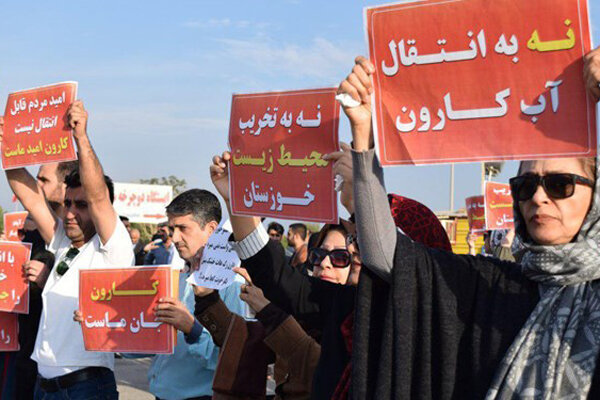The water crisis in Iran has become one of the main crises. One of the worst-hit areas is the south-western province of Khuzestan.
Now many days the farmers in this region are protesting water scarcity. But the situation is not limited to the of the farmers and the daily life of the people is collapsed having no drinking water. The provincial water and electricity organization is forced to supply water to many villages in the province by tanker, which of course is not enough, and, in many situations, it does not even cover the daily need of one day.
Many people in this province consider the transfer of Khuzestan water to the central plateau of Iran as one of the most important causes of water shortage in their province these days. And mismanagement of water resources added to the drought has made the people of this province become thirsty.
About one-third of the country’s current water resources should flow naturally to Khuzestan province, but since the beginning of the ’80s, various projects have been implemented in Karun and Dez springs, and now a large part of the water of these two rivers is directed to Isfahan and Yazd provinces.
Meanwhile, before the water stress this year, about 700 villages in Khuzestan were supplied with water by tanker, and now, with the drying of the end branches of Karkheh, the number of these villages has exceeded a thousand, which is a clear indication that the thirst of the people has nothing to do with the claims of the government about the drought.
Seyed Ahmad Avaei, an MP, described the transfer of Khuzestan water to the central plateau of Iran as the most important cause of water shortage in his province and said to the state-run news agency Rokna: “Unfortunately, the implementation of water transfer projects from the sources of Dez and Karun began from the government of the late Hashemi. This, of course, was a grave mistake from the beginning, and subsequent governments are continuing to do so.”

He added: “Transferring water from Khuzestan to the central plateau of Iran is a mistake, unprofessional and highly anti-environmental, which has harmed the people of Khuzestan, especially the people of the cities and villages below these rivers. After the ‘economy-first’ government (Akbar Hashemi Rafsanjani), while the governments continued to make this mistake, many experts emphasize that the solution for the development of the central provinces is not the transfer of water from Khuzestan.
“Even some officials of this government admit that the continuation of water transfer from the sources of Dez and Karun to the central plateau of Iran is wrong, and when I spoke with the current head of the Environment Organization, he also acknowledged that this should not be done.”
Then he confessed about the misuse of this transferred water while he acknowledged that this water is used for agricultural and industrial issues which in many cases are the unnecessary projects lead by the IRGC and said:
“If the officials of the previous governments wanted to provide only drinking water to the people of the central provinces, they could have solved the problem of the people of Isfahan, Yazd, etc. by building pipelines that carry only as much water as the drinking water of these provinces. But unfortunately, the share of water that can lead to the development of Khuzestan has been transferred to the central plateau of Iran for many years for the development of industry and agriculture.”
Many others in this government also criticized this action, including Ahmad Avai, MP from Dezful, who said, “The strategy for the development of these provinces was not the transfer of water from the sources of Karun and Dez from the very beginning, and this measure has led to unbalanced development in the country so that agricultural water and industrial water of the central provinces are often provided, but the people of Khuzestan, especially the farmers of this province, face the water crisis at many times.”
Koohrang 2 pipeline was one of the most important pipelines for transferring water from Khuzestan to the central plateau of Iran and currently the Ministry of Energy is building the Koohrang 3 pipeline to complete water transfer projects from Dez and Karun springs to the central plateau of Iran.


